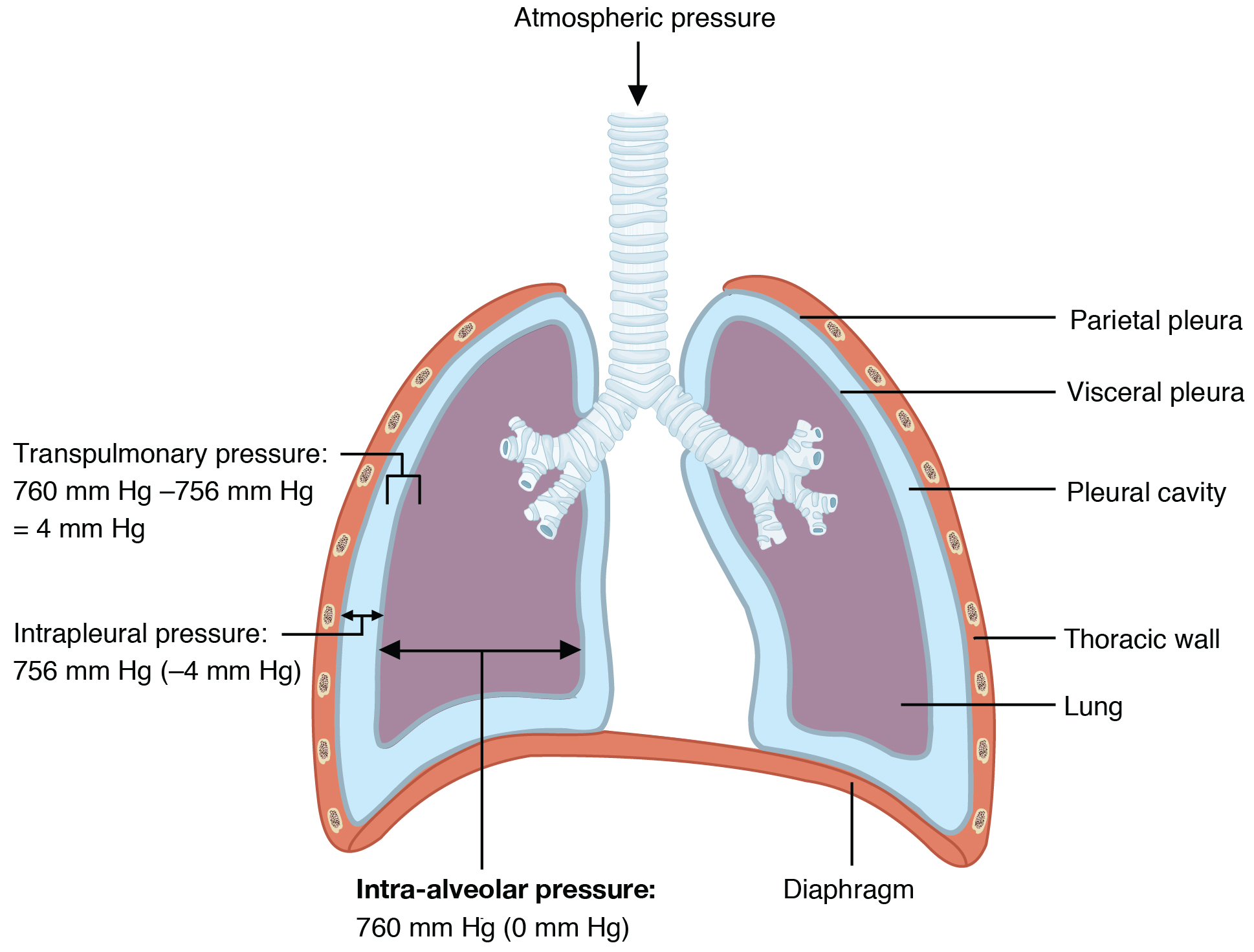61 Pulmonary pressures
Learning Objectives
After reading this chapter, you should be able to-
- Define atmospheric pressure, intrapulmonary pressure, intrapleural pressure, and transpulmonary pressure.
- Explain the relationship of intrapleural pressure, transpulmonary pressure, and intrapulmonary pressure relative to atmospheric pressure during ventilation.
Pulmonary ventilation is the act of breathing, which can be described as the movement of air into and out of the lungs. The major mechanisms that drive pulmonary ventilation are atmospheric pressure (Patm); the air pressure within the alveoli, called alveolar pressure (Palv); and the pressure within the pleural cavity, called intrapleural pressure (Pip).
Mechanisms of Breathing
The alveolar and intrapleural pressures are dependent on certain physical features of the lung. However, the ability to breathe—to have air enter the lungs during inspiration and air leave the lungs during expiration—is dependent on the air pressure of the atmosphere and the air pressure within the lungs.
Pulmonary ventilation is dependent on three types of pressure: atmospheric, intra-alveolar, and interpleural. Atmospheric pressure is the amount of force that is exerted by gases in the air surrounding any given surface, such as the body. Atmospheric pressure can be expressed in terms of the unit atmosphere, abbreviated atm, or in millimeters of mercury (mm Hg). One atm is equal to 760 mm Hg, which is the atmospheric pressure at sea level. Typically, for respiration, other pressure values are discussed in relation to atmospheric pressure. Therefore, negative pressure is pressure lower than the atmospheric pressure, whereas positive pressure is pressure that it is greater than the atmospheric pressure. A pressure that is equal to the atmospheric pressure is expressed as zero.
Intra-alveolar pressure is the pressure of the air within the alveoli, which changes during the different phases of breathing (Figure 61.1). Because the alveoli are connected to the atmosphere via the tubing of the airways (similar to the two- and one-liter containers in the example above), the interpulmonary pressure of the alveoli always equalizes with the atmospheric pressure.

Intrapleural pressure is the pressure within the pleural cavity due to the fluid bond between the visceral and parietal pleura and the parietal pleura’s adhesion to the body wall and diaphragm. Similar to intra-alveolar pressure, intrapleural pressure also changes during the different phases of breathing. However, due to certain characteristics of the lungs, the intrapleural pressure is always lower than, or negative to, the intra-alveolar pressure (and therefore also to atmospheric pressure). Although it fluctuates during inspiration and expiration, intrapleural pressure remains approximately –4 mm Hg throughout the breathing cycle.
Competing forces within the thorax cause the formation of the negative intrapleural pressure. One of these forces relates to the elasticity of the lungs themselves—elastic tissue pulls the lungs inward, away from the thoracic wall. Surface tension of alveolar fluid, which is mostly water, also creates an inward pull of the lung tissue. This inward tension from the lungs is countered by opposing forces from the pleural fluid and thoracic wall. Surface tension within the pleural cavity pulls the lungs outward. Too much or too little pleural fluid would hinder the creation of the negative intrapleural pressure. Since the parietal pleura is attached to the thoracic wall, the natural elasticity of the chest wall opposes the inward pull of the lungs. Ultimately, the outward pull is slightly greater than the inward pull, creating the –4 mm Hg intrapleural pressure relative to the intra-alveolar pressure.
Transpulmonary pressure, a critical determinant of lung size, is defined as the difference between intra-alveolar and intrapleural pressures. Intrapleural pressure, which remains negative throughout the breathing cycle, is influenced by factors such as lung elasticity, surface tension of alveolar fluid, and opposing forces within the thorax. This pressure difference plays a pivotal role in regulating lung expansion and contraction during ventilation. Higher transpulmonary pressure corresponds to a larger lung, highlighting its significance in the mechanics of breathing.
Adapted from Anatomy & Physiology by Lindsay M. Biga et al, shared under a Creative Commons Attribution-ShareAlike 4.0 International License, chapter 22
the movement of air in and out of the lungs
the amount of force that is exerted by gases in the air surrounding any given surface, such as the body, expressed in millimeters of mercury (mmHg) or atmospheres (atm); 760 mmHg at sea level
pressure of the air within the alveoli
pressure within the pleural cavity due to the fluid bond between the visceral and parietal pleura, and the parietal pleura’s adhesion to the body wall and diaphragm
the difference between intra-alveolar and intrapleural pressure

